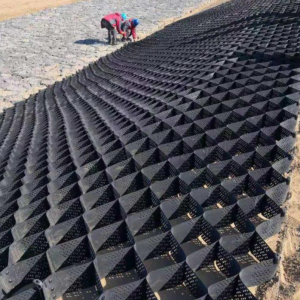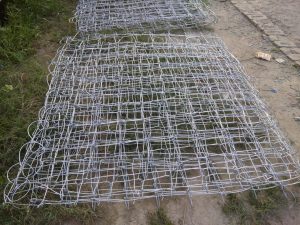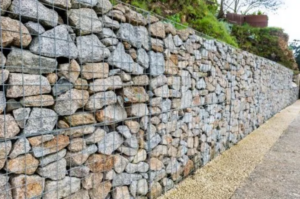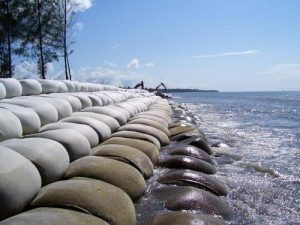Types of Geocells and Geogrids and their Materials.

A number of model experiments were conducted in this work to gain a better knowledge of how the geocell material affects the load-carrying mechanism of geocell-reinforced sand foundations under strip loading. Geogrids of various forms were used to create geocells of various types. The following characteristics were investigated: footing load-settlement response, fill surface deformation, geocell strain, pressure transferred to the subgrade soil beneath the geocell mattress, and load dispersion in the geocell mattress.
The test findings show that the reinforced-sand foundation bed’s performance is influenced by the strength, stiffness, aperture opening size, and orientation of the geocell material’s rib. Geocells with higher-strength geogrids, smaller aperture openings, and orthogonal-oriented ribs increase performance. There are two types of geocells: non-perforated geocells and perforated geocells. Long-term performance of our geosynthetics products is excellent. They may be used in a variety of soil types. Our geogrids and geocells are widely employed in a variety of reinforcing applications.
Table of Contents
Geogrid is a geosynthetics product. Polypropylene and other polymers are used to make it. Geogrids are divided into four categories based on their basic materials: plastic geogrid, steel plastic geogrid, fibreglass geogrid, and polyester geogrid. Uniaxial geogrid, biaxial geogrid, and triaxial geogrid are the three varieties of plastic geogrid. There are two types of geocells: non-perforated geocells and perforated geocells. Long-term performance of our geosynthetics products is excellent. They may be used in a variety of soil types. Our geogrids and geocells are widely employed in a variety of reinforcing applications.
The benefits of Tigergrid
- R&D staff with years of experience.
- Process of selecting high-quality raw materials.
- Product technology that has been created by the company itself.
- Equipment for professional production.
- System of strict production management.
- International standard for quality assurance testing.
- Designing specialised solutions is a service that we offer.
Geogrid with a single axis
A one-directional construction distinguishes a uniaxial geogrid. It has a high resilience to damage caused by building. It may be used in a variety of reinforced earth structures.
Geogrid with two axes
Load is distributed in two directions via a biaxial geogrid. It has strong load capacity, flexural stiffness, and long-term stability.
Geogrid with three axes
Triaxial geogrid features a triangle grid construction that is unique. It offers exceptional aperture stability and in-plane rigidity.
Geogrid made of plastic
Plastic geogrid has a high junction efficiency and is corrosion resistant. It comes in a variety of sizes and forms. Geogrid made of steel and plastic
Steel plastic geogrid is used in retaining wall strengthening and railroad construction because of its high strength and bearing capacity.
Geogrid made of fibreglass
Fiberglass geogrid uses a weaving process that is unique. It has a high tensile strength and is thermally stable. This item is suited for long-term tasks. Geogrid made of polyester
Polyester geogrid offers a high level of long-term deterioration resistance. It’s extensively utilised to strengthen railroad, subway, and highway subgrade structures.
Geocell Geocell has a honeycomb structure that is tightly interwoven. The aggregate interaction is substantially improved by this structure. Geocell is a great way to keep soil from eroding and water from evaporating.
A variety of uses
- Reinforcement of the subgrade and the ground.
- Slope and retaining wall reinforcement
- Abutments for bridges.
- Stabilization of the soil and earth.
- Slope protection on a steep incline.
- Improvements to the airport runway, parking lot, and landfill.
- Improvements to the road and pavement.
- Reinforcement of the embankment and asphalt pavement
- Reinforcement of the embankment and levees.
- Protection of tree roots and riverbeds.
- Construction of a channel wall, a road, and a highway.
- Controlling erosion with a greenbelt and plants.
- Install the platform application.
Possessive qualities
- Aperture stability is excellent.
- In-plane stiffness is high.
- Load distribution is good.
- Mechanical interlock mechanism that works well.
- Structural stability throughout time.
- Exceptional corrosion resistance.
- It is economical.
FAQs
Can Geocell be used in road construction?
Yes, Geocell is widely used in road construction to improve load-bearing capacity, reduce rutting, and enhance pavement performance.
Can Geocell be used in mining applications?
Yes, Geocell can be used in mining applications for slope stabilization, access roads, and erosion control.
Is Geocell suitable for reinforcing weak foundations?
Yes, Geocell can be used to reinforce weak foundations by providing additional support and improving load distribution.



